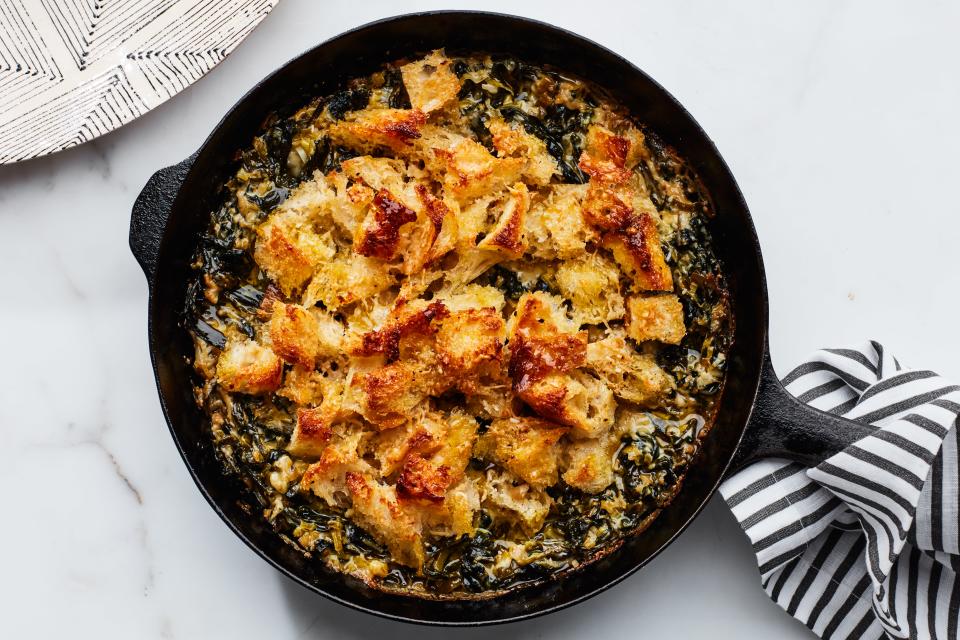How to Make Olive Oil-Fried Croutons, the Best Croutons on the Planet
Several years ago, while on a trip to Seville, I fell in love with gazpacho. Real gazpacho. Instead of the Americanized quick-blitzed purée of tomato juice and vegetables that often goes by the same name, this was a deeply flavorful blend of ripe red tomatoes, soaked bread, and a few almonds, seasoned with good salt, crushed garlic, and a touch of sherry vinegar.
But the real revelation was what was on top of the soup: chopped hard-cooked eggs, strips of Spanish ham, and—the sleeper hit—warm, crisp-tender croutons that practically dripped with olive oil.
In my kitchen back home, that olive oil-fried bread went into heavy rotation. I used it to top everything from soups and salads to cooked greens, eggs, and baked fish dishes. When it came to desserts, I didn’t discriminate, sprinkling it over ice cream and chocolate pudding and anything else that could use some crunch.
What you get when you fry bread in olive oil are golden-edged, crisp-tender croutons with the sort of warm olive fruitiness you can only get by frying. Sure, you can get croutons by tossing some bread in oil and sliding it into an oven. But the dry cubes you get that way are better as meal prep for a Thanksgiving stuffing. As toppings for salads or greens, they can’t hold a candle to the fried version.
I know what you’re thinking—you don’t want to fry. Too splattery, too much of a mess. But what we’re talking about here is a shallow fry—the quick, easy kind that makes olive oil fried croutons doable on a weeknight.

Spring Greens Gratin recipe
Olive oil-fried croutons can be made with bread that’s torn into misshapen pieces, or bread that’s cut into perfect square cubes. You can keep the pieces big or small, and make them garlicky, spicy, or herby. In other words, you can pretty much customize your croutons to be whatever you want, as long as you follow this basic method:
How to Make Olive Oil-Fried Croutons
To make about 2 cups of croutons, tear or cut enough rustic country bread to yield about 2 cups of 1/2-inch bread cubes. Heat 1/3 inch extra-virgin olive oil in a medium skillet over medium-high heat. When you see the oil ripple and bubble, add 1 cube. If it’s hot enough, then oil will bubble up around the cube’s edges. When it does, add the rest of your bread in a single layer. Fry undisturbed until the pieces are lightly golden on the bottom (30 seconds to a minute, depending on the moisture content of your bread), then turn the cubes with tongs and continue frying them until just lightly golden, a minute or so more. (Be careful not to over-fry your croutons—you’re going for crispy on the outside with a tender bite, not crunchy and crusty). Transfer cubes to paper towels to drain, seasoning with salt and pepper while warm.
As long as your crouton is salted and olive oil-fried, it’s going to be pretty sublime. Still, there are some ways you can elevate it.
First, pay attention to your ingredients. The better your bread, the better the crouton (I go for crusty, rustic, sourdough miche types). And the more flavorful your olive oil, the more flavorful the fried bread (though you should use your really nuanced—and pricey—olive oils for finishing dishes, not for frying).
When you salt you croutons, salt them generously. And if you want to go one step further, sprinkle the croutons with a good chili powder, some sumac or a little smoked paprika. (If you’re adding a peppery spice—say Aleppo pepper or urfa biber—go easy on the black pepper, or skip it altogether.) Alternatively, add a smashed and peeled garlic clove and a few sprigs of a fresh woodsy herb, like rosemary, thyme, or oregano, to the oil before heating it, leaving them in the pan as your croutons fry. The herbs will crisp and the garlic will poach, both releasing their flavor as they cook.
Finally, try to eat these croutons the same day you make them. The next day they’ll morph into more of an everyday baked crouton—and that, of course, is what you’re trying to avoid.
Originally Appeared on Epicurious

